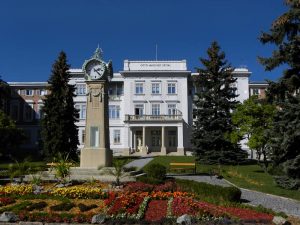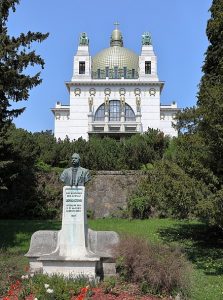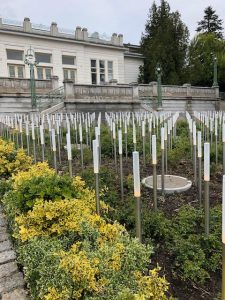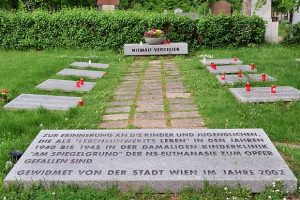Before I conclude my own personal homage to Vienna’s most famous architect (coming in a few weeks when I write about Otto Wagner’s stunning Österreichische Postsparkasse) I want to look again at the Otto-Wagner-Spital which we visited a few days back.

In the previous post, I made reference to the fact that the Otto Wagner Hospital in Vienna will be re-named on August 1, becoming Vienna’s Klinik Penzik. I also mentioned that the overall site – beautifully landscaped – would continue to function (as now) as a public park. At the same time, part of the site will become the new location of the Central European University (CEU) as it moves from Budapest to Vienna, with classes beginning in 2022/23.
Along with the university, health care continues to be a strong focus as well, and even as far back as 2000 five health facilities were consolidated under the label Sozialmedizinisches Zentrum Baumgartner Höhe – Otto Wagner Spital mit Pflegezentrum (Baumgartner Höhe Social Medicine Center – Otto Wagner Hospital and Care Center). The five facilities are:
- Förderpflegeheim Baumgartner Höhe (nursing home)
- Neurologisches Krankenhaus Maria-Theresien-Schlössl (neurology)
- Pflegeheim Sanatoriumstraße (nursing care)
- Psychiatrisches Krankenhaus Baumgartner Höhe (psychiatry)
- Pulmologisches Zentrum Baumgartner Höhe (pulmonology).

As for the hospital itself (often referred to as the Psychiatrisches Krankenhaus), it was a large mental hospital opened in 1907 after three years of construction. When it was built, the hospital was one of the most modern and largest psychiatric clinics in Europe, and its planning and construction, with Leopold Steiner the site manager (later honored with his statue directly below the church at the base of the hill, a recognition which in all probability could not have been topped!). The overall planning and site plan were under the direction of the Lower Austrian state government, supervised by Carlo von Boog. There are different stories about Otto Wagner’s participation, and I was told by more than one person that he did not work on the entire hospital site, although of course the church – in my opinion his great masterpiece – dominated his many projects during the time of his work at the site. Walter Zednicek in Weiner Architektur um 1900 writes “The Steinhof church in the middle of a newly constructed psychiatric hospital is a landmark in ecclesiastical architecture, not only for the time in which it was built. With this central building, Wagner experimented with aspects such as the development of a Gesamtkunstwerk (total work of art), involving numerous visual artists. … It is noteworthy that Wagner always worked on several projects at once, overseeing their implementation.” This seems to explain Wagner’s sometimes designation as the site’s “overall” architect although, as I say, there are others who point out only the church and specific items, such as lampposts and other practical Art Nouveau ironwork.
But the beauty of the place is not today’s story. There is another story, and it is equally important. Of course when we visit a place like Steinhof it’s necessary to enjoy and even to study its stunning architecture. At the same time, especially in this case and in the difficult times in which we are now living, it is critical also to concentrate on what can happen when evil takes control in a society and seems to become a defining characteristic for how that society functions. That’s what happened at the site we’re enjoying now, and I find myself giving attention to what I think of as the dark side of am Steinhof, as the hospital was colloquially referred to before World War II.

The visitor gets a first cue in the walk up to the church and later, after leaving the church and upon leaving the Art Nouveau Theater, observing the area in front of it. We are looking at the Gedenkstätte zur Geschichte der NS-Medizin in Wien (Memorial to the History of Nazi-Medicine in Vienna), which serves as both a memorial and, within Pavilion Five, as an exhibition describing what happened in the hospital. One authority describes the memorial – a beautifully laid-out garden space honoring the victims – as “a striking memorial for the victims of the Spiegelgrund murders, made up of rows of subtly illuminated lights in a field in front of the complex’s theatre building.” Despite the lack of pretension, both the memorial and the exhibition commemorate and chronicle this dark legacy of the Nazi medical programs. This can be seen in an occasional reference to both as the “Memorial Steinhof,” with the emphasis – as can be seen in the photographs in the album accompanying this post – on Nazi euthanasia and medical crimes at Steinhof.
I had the experience of learning more about what had happened at am Steinhof, in addition to admiring the beautiful grounds and its architecture. I did so when I was invited to enter Pavilion Five and visit the onsite exhibition dedicated to the Nazi past and the horrors that were inflicted on children and young people. I had never heard about this particular activity taking place under the Nazis, although I had read enough books about the war and what was happening in Germany that I think I must have had an idea. I was not prepared, though, for what I learned. When I arrived in Pavilion Five and went up to the exhibition on the first floor. I was surprised to see what appeared to be a class of university-age students, perhaps even graduate students, gathered around two lecturers who were giving a detailed history of the events described in the exhibition. The specific exhibition is called Kindereuthanasie in Wien 1940-1945, and it isn’t exceptionally large, but it is gripping (there’s no other way to describe it). Primarily, it seems to be a specialist type of exhibition, with many large poster-like graphic representations (most of which – as can be seen in the photographs in the accompanying album – only use German). And the exhibition obviously does not attract the general tourist; indeed, I was the only person viewing the exhibition aside from the students and their lecturers, and they were all obviously engrossed in what they were discussing (as for me, I could understand but little of what was being said, but no one seemed to mind that I was listening).
The subject of the exhibition is the Kinderfachabteilung in Vienna, the Städtische Jugendfürsorgeanstalt “Am Spiegelgrund” Wien. It operated from late July 1940 until May 1945, and it has been described in several enlightening studies. For our purposes (at least for me) most of these must be accessed via Google Translate, but reading them is worth the effort. And we can’t get away from the fact that, even in translation (which in this case seems to be very well done), the story told here is almost overwhelming in the overall sadness and terrifying emotions it evokes. We can’t help but ask how such dastardly events could have taken place. And even with what we know now about the horrors of World War II and after reading so many studies and so much historical fiction on the subject, the very idea of the Kindereuthenasia is a frightening and horrifying page from the past to learn about.

Leave a Reply